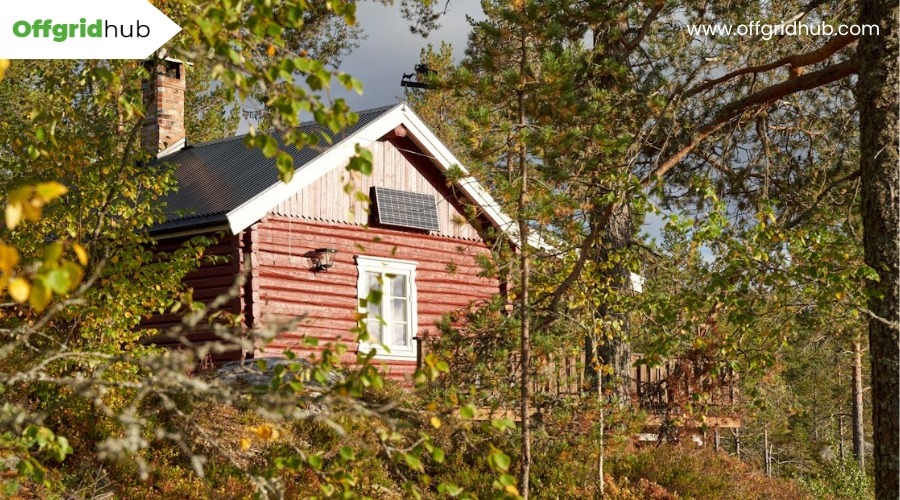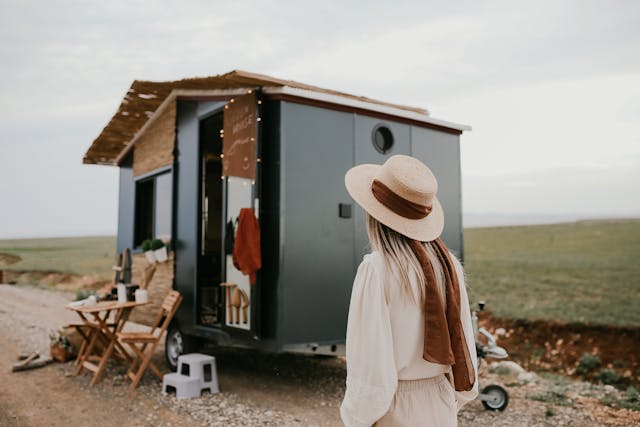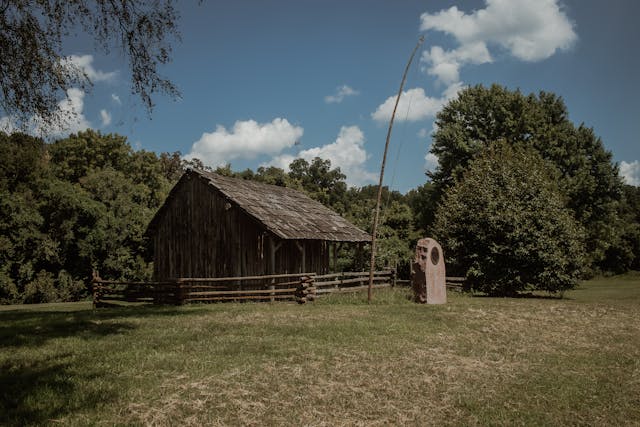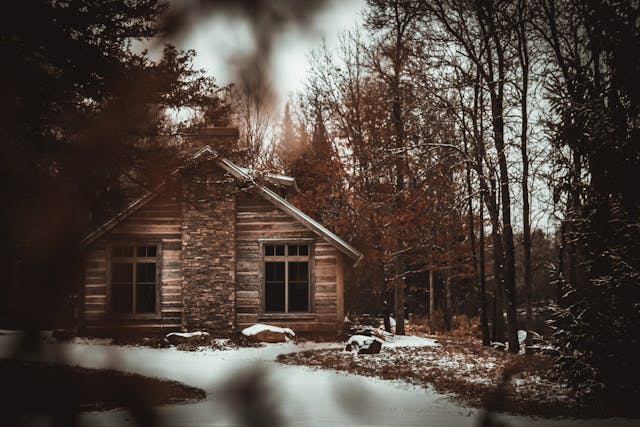Embarking on the journey to build a tiny home off-grid is akin to planting a seed of independence in the fertile ground of sustainability. You’ll need to consider how you’ll harness the sun’s power for energy, capture rain for water, and manage waste in a way that nourishes the earth rather than harming it.
The blueprint for such an endeavor includes not only practical considerations like insulation and efficient design but also the legal landscape that can either nourish or stifle your growth. With the right knowledge, you’re on the path to cultivating a life that’s both minimalist and richly rewarding.
Why is this path worth exploring further?
Selecting the Ideal Location
Choosing the ideal location for your off-grid tiny home requires considering factors like optimal sun exposure, privacy, access, nearby activities, and cost. Optimal sun exposure is crucial for your tiny home, especially if you’re relying on solar panels for power. You’ll need a spot that gets plenty of sunlight to maximize efficiency. However, don’t overlook privacy factors. A location surrounded by shaded, treed areas can offer both seclusion and protection from the elements.
Proximity to a main road is another key consideration. Being close enough for easy access, especially during winter months for snow removal, is important. Yet, you don’t want to compromise your off-grid living experience with too much noise or traffic. Recreational activities in the area can also enhance your lifestyle, providing you with enjoyable ways to spend your time without straying too far from home.
Lastly, affordability and cost considerations can’t be ignored. The cost of the land itself, along with any preparations needed for your tiny home, can vary widely. Finding the ideal location means balancing your desire for a perfect off-grid living experience with the practicalities of what you can afford.
Legal and Zoning Considerations
Before you lay the foundation for your tiny home off-grid, it’s essential to navigate the complex landscape of zoning laws and legal requirements. Zoning laws can significantly influence where you’re allowed to establish your tiny home, dictating everything from the size of your dwelling to its location. Don’t overlook the importance of researching local ordinances and regulations early in your planning process.
Securing the necessary permits is another critical step towards off-grid living. This may include obtaining septic permits if you’re managing your waste or building permits to ensure your tiny home meets all health and safety codes. These codes are in place to guarantee a habitable environment, safeguarding your well-being and that of the surrounding community.
Moreover, you must consider other legal considerations such as land use restrictions, environmental impact assessments, and waste disposal regulations. These regulations are designed to minimize your ecological footprint and promote sustainable living practices.
Understanding and adhering to these legal frameworks is vital. It not only helps you avoid potential fines or penalties but also ensures a smooth transition to a self-sufficient living arrangement. Be thorough in your research and proactive in compliance to make your off-grid tiny home dream a reality.
Designing for Efficiency and Sustainability
When designing your off-grid tiny home, it’s crucial to focus on efficiency and sustainability to ensure a minimal environmental footprint and optimal living conditions. Maximizing solar orientation not only aids in energy harvesting but also plays a significant role in passive solar design. This approach, coupled with top-notch insulation and strategic ventilation, helps maintain comfortable temperatures year-round while keeping energy consumption low.
Sustainability doesn’t stop at energy efficiency. Selecting high-quality materials, including reclaimed ones, contributes to both the durability of your home and the reduction of environmental impact. It’s a win-win that aligns with the ethos of tiny living.
However, don’t overlook the importance of compliance. Building codes, permits, and local requirements are there to ensure safety and legality. Navigating these regulations is essential for a smooth project.
| Aspect | Emotion Evoked |
|---|---|
| Solar Orientation | Hopefulness |
| Insulation | Comfort |
| Ventilation | Freshness |
| Reclaimed Materials | Pride |
Incorporating these elements into your design not only enhances the sustainability and efficiency of your tiny home but also fosters a deep sense of satisfaction and connection to your living space.
Power Generation Options
To power your off-grid tiny home sustainably, you’ll need to consider various energy generation options that align with the environment and your living needs. Solar panels are a popular choice, offering renewable energy that has minimal environmental impact. They’re practically synonymous with off-grid living, capturing sunlight and converting it into electricity for your daily use.
But, solar energy isn’t the only option. If you’re in a windy area, wind turbines can be an effective way to harness natural resources to generate power. These can complement solar panels, providing energy during cloudy or stormy days when solar output might be lower.
For those lucky enough to be near flowing water, hydroelectric power presents another renewable energy source. This method uses water flow to generate electricity, adding to the diversity of off-grid power generation options.
However, relying solely on renewable energy sources can sometimes leave you short, especially during periods of low sun or wind. That’s where backup generators come into play. They provide reliability, ensuring you have power even during low production periods. Integrating a mix of renewable energy sources with a backup generator allows for a sustainable, reliable, and environmentally friendly off-grid living experience.
Water Collection and Management
Rainwater harvesting often serves as a cornerstone for water collection and management in off-grid tiny homes, ensuring you’ve got a sustainable supply. This method involves collecting and storing rainwater, which can be a game-changer for your water supply needs. But it’s not the only option. If you’re situated above a reliable aquifer, tapping into well water can provide a consistent source, crucial for your off-grid tiny home’s sustainability.
In areas where neither rainwater nor well water is viable, water delivery services can fill the gap, ensuring you don’t run dry. However, whether you’re relying on collected rainwater, well water, or deliveries, water filtration and purification are non-negotiable. These systems are key to making sure your water isn’t just available, but also clean and safe for consumption.
Managing your water wisely is critical in an off-grid setting. Efficient water management strategies ensure your off-grid tiny home maintains a steady, safe water supply without overtaxing limited resources. By integrating rainwater harvesting, exploring well water options, considering water delivery, and installing robust water filtration and purification systems, you’ll set a solid foundation for water collection and management in your off-grid lifestyle.
Waste Disposal Solutions
Having established a sustainable water supply, it’s equally important to address how your off-grid tiny home manages waste. Waste disposal isn’t just a necessity; it’s a central feature of sustainable living, ensuring your eco-friendly footprint on the environment. Off-grid tiny homes have unique solutions that align with the principles of waste management and sustainable living.
Here are three effective waste disposal solutions:
- Composting Toilets: These are a popular choice, transforming human waste into compost. This method not only reduces water usage but also provides an eco-friendly way to repurpose waste.
- Incinerator Toilets: For those who prefer a more high-tech solution, incinerator toilets burn waste at high temperatures, reducing it to ash. This option is particularly useful in minimizing waste volume and handling.
- Greywater Systems and Septic Systems: Greywater systems recycle water from sinks and showers for irrigation, promoting water conservation. Meanwhile, septic systems offer a more traditional approach, accommodating larger waste volumes effectively.
Incorporating these waste disposal solutions into your off-grid tiny home ensures a clean, sustainable living environment, crucial for eco-friendly and off-grid lifestyles.
Insulation and Climate Control
Your off-grid tiny home’s comfort and energy efficiency hinge significantly on the quality of its insulation and climate control systems. Proper insulation not only helps regulate indoor temperatures, ensuring you’re not too hot in summer or too cold in winter, but it also plays a vital role in reducing heat loss or gain. This means you’ll need less energy to keep your space comfortable, a crucial aspect of living off-grid.
Quality insulation materials, such as Structural Insulated Panels (SIPs), are commonly utilized in tiny homes for their superior energy efficiency. These panels not only keep your home at a pleasant temperature but also prevent moisture buildup and mold growth, ensuring a healthy living environment. Remember, effective insulation is your first line of defense against external temperature fluctuations, making it indispensable for comfortable living in various climates.
Moreover, your tiny home’s climate control significantly relies on the synergy between insulation quality and ventilation systems. A well-ventilated space reduces the risk of moisture accumulation, further enhancing the effectiveness of your insulation. Together, these systems ensure your off-grid tiny home remains a comfortable, energy-efficient haven, regardless of the weather outside.
Choosing Sustainable Materials
After addressing the importance of insulation and climate control, it’s crucial to focus on selecting sustainable materials for your off-grid tiny home. The choice of materials not only impacts your home’s eco-friendliness but also its durability and the overall environmental footprint.
- Utilize Reclaimed and Renewable Materials: Opt for reclaimed wood for your structure and interior finishes. It’s not just about the unique aesthetic; reclaimed wood reduces deforestation and waste. Additionally, incorporate renewable materials like bamboo for flooring or cork, which aren’t only sustainable but also add distinctive character to your home.
- Invest in Energy-Efficient Windows and Insulation: Choosing windows that are designed to conserve energy can significantly reduce your heating and cooling costs. Pair these with insulation made from recycled materials to enhance your home’s sustainability and comfort.
- Select Non-Toxic Finishes: Low-VOC paints and finishes minimize air pollution indoors and out, safeguarding your health and the environment. By choosing these, you’re not just building a home; you’re committing to eco-friendly living.
Off-Grid Internet and Communication
In an off-grid tiny home, securing a reliable internet and communication setup is crucial for staying connected to the wider world. Off-grid internet solutions like satellite internet, cellular hotspots, and fixed wireless options are your go-to choices. These technologies ensure you’re not cut off, whether you’re remote working or engaged in online schooling. You’ll need the right equipment, including routers, antennas, and signal boosters, to make the most of these services.
For communication, don’t overlook the importance of satellite phones, two-way radios, and CB radios. These tools can be lifesavers in areas where traditional cell service falters. They ensure you can reach out for help, stay in touch with nearby friends or family, and maintain a line of communication with the outside world under any circumstances.
Moreover, embracing communication redundancy is a smart move. Having multiple ways to connect can prove invaluable, especially in emergencies. Whether it’s a satellite internet backup or an extra two-way radio, ensuring you have alternative methods to communicate can make all the difference in off-grid living. This approach keeps you prepared and connected, no matter what challenges you might face.
Maintenance and Upkeep Strategies
Maintaining your tiny home’s off-grid systems, such as solar panels and water filtration, is crucial for ensuring long-term efficiency and reliability. Regular upkeep not only prevents unexpected breakdowns but also guarantees that you’re living sustainably and comfortably. Here’s how you can keep your off-grid systems in top shape:
- Solar Panel Maintenance:
Implement a cleaning schedule to remove dust and debris, which can significantly reduce energy production. Solar panels are the heart of your power supply, and their efficiency directly impacts your energy storage and prevents power shortages. Regular inspections can identify potential issues before they escalate.
- Battery Monitoring:
Keeping an eye on your battery levels and performance is vital. Effective battery monitoring ensures that you’re not caught off guard by power shortages and maximizes your energy storage capabilities. It’s about staying powered, not just getting powered.
- Water Filtration and Waste Disposal:
Ensure that your water filtration systems are routinely checked to provide a clean and safe water supply. Additionally, regularly empty and maintain composting toilets to promote proper hygiene and waste disposal. This not only keeps your living environment healthy but also impacts the sustainability of your tiny home.
Conclusion
Building your off-grid tiny home is an adventure that’ll test your creativity and commitment to sustainability. By selecting the right spot, understanding legal requirements, and designing with efficiency in mind, you’re setting the foundation for a self-sufficient lifestyle.
Incorporating renewable energy, managing water wisely, and choosing sustainable materials are key. Remember, maintenance is ongoing, but the freedom and satisfaction you’ll gain are unparalleled.
Embrace the challenges and enjoy the independence of your eco-friendly, tiny home living.




